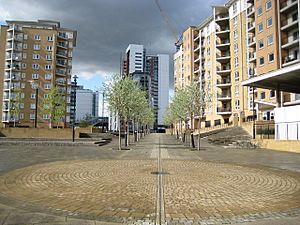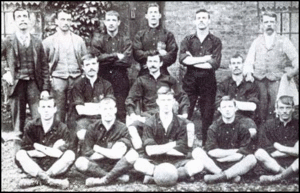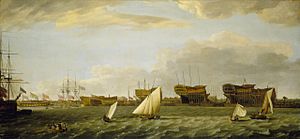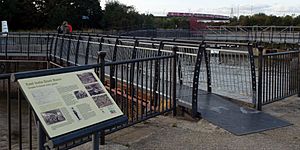Blackwall, London facts for kids
Quick facts for kids Blackwall |
|
|---|---|
 Virginia Quay, the line that runs down the centre of the avenue marking the prime meridian |
|
| Population | 19,461 (2011 Census. Blackwall and Cubitt Town Ward) |
| OS grid reference | TQ385805 |
| London borough | |
| Ceremonial county | Greater London |
| Region | |
| Country | England |
| Sovereign state | United Kingdom |
| Post town | LONDON |
| Postcode district | E14 |
| Dialling code | 020 |
| Police | Metropolitan |
| Fire | London |
| Ambulance | London |
| EU Parliament | London |
| UK Parliament |
|
| London Assembly | |
Blackwall is a cool area in East London, part of a bigger place called Poplar. It's located in the London Borough of Tower Hamlets. This neighbourhood includes places like Leamouth and a special historic area called Coldharbour.
Blackwall got its name from an old wall built along the River Thames. This wall helped protect the land from floods. Like Poplar, Blackwall was once part of a very old area called Stepney. Today, many people live here, but you can still see boats docked at Poplar Dock and Blackwall Basin.
Contents
Why Blackwall is Special
Blackwall was important because of its location on a bend in the River Thames. The river currents here were slower, making it a safe spot for ships. There was also a reef called the Blackwall Rock, which helped shelter boats, though it could also be a danger. Another great thing about Blackwall was that it was east of the Isle of Dogs. This meant ships could load and unload without having to sail all the way around that peninsula to get to London.
The area grew along the river next to Poplar's East Marsh. People have called it Blackwall since at least the 1300s. Its name comes from the colour of the river wall, which was built in the Middle Ages. Blackwall doesn't have official borders, but it's generally the part of Poplar near the Thames, on the north-east side of the Isle of Dogs. It stretches east to where the Thames meets the Lea.
The part of the Thames east of the Isle of Dogs is called Blackwall Reach. This stretch of river also gives its name to Blackwall Point, which is on the northern tip of the Greenwich Peninsula (south of the Thames in Greenwich, not in Blackwall itself).
Blackwall's Past
Blackwall Yard became a very important place for ships, making Blackwall a big part of the Port of London. It was involved in major sea journeys for over 400 years! People were already fixing ships here by 1485, and later on, they started building ships too.
In 1576, explorer Martin Frobisher sailed from Blackwall. He landed at Frobisher Bay in Canada, claiming it for Queen Elizabeth I and England. This was England's first overseas land! Frobisher's trip was paid for by the Muscovy Company, who were looking for a way to sail through the North West Passage.
In the early 1600s, Blackwall was the main starting point for England's efforts to set up colonies in North America and the West Indies. On December 20, 1606, three ships named Susan Constant, Godspeed, and Discovery sailed from Blackwall. They landed in Virginia on April 26, 1607, and started the first permanent English settlement called Jamestown.
The East India Docks and West India Docks were built here in the early 1800s.

Leamouth Wharf was home to big shipyards like Samuda Brothers, Orchard House Yard, and Thames Iron Works. These places provided many jobs. In 1895, Arnold Hills, who owned Thames Iron Works, and his foreman Dave Taylor started a football team for their workers called Thames Ironworks F.C.. This club later changed its name to West Ham United F.C..
Until 1987, Blackwall was a busy centre for building and repairing ships. The Blackwall Yard built the first Blackwall Frigates, which were fast sailing ships. You can still see two of its old dry docks today near the Reuters building.
The London and Blackwall Railway was one of London's first railway lines, starting in 1840. It was a short trip, less than twenty minutes, from Fenchurch Street Station to Blackwall. But it was very important for connecting to passenger boats going to Gravesend. Near the Blackwall railway station was the Brunswick Hotel. In its early days, fancy people, including King William IV, visited it. Its main customers were people moving to places like Australia, who would wait there for small boats to take them to bigger ships at Gravesend.
The Blackwall Tunnel, which opened between 1892 and 1897, carries cars under the Thames. It connects Blackwall to the Greenwich Peninsula.
The Brunswick Wharf Power Station was built in 1952. It was a bit controversial because people worried about air pollution in such a busy part of London.
What Blackwall Looks Like Today

Coldharbour Conservation Area

Coldharbour is described as the "only remaining piece of the old Blackwall" and "one of the last examples of the narrow streets that used to be all along the river." Today, it's mostly homes and no longer has industrial or shipping activities. The Coldharbour Conservation Area was set up in 1975 and expanded in 2008. It has several old buildings and engineering structures that were once part of the docks.
Working Wharves
Northumberland Wharf is still a working wharf today. It's a special place protected by the Mayor of London and the Port of London Authority (PLA). Cory Riverside Energy runs it, and they also manage a recycling centre next to the wharf. They use barges to transport waste along the River Thames.
New Homes
In the 1980s, Blackwall saw its first big housing project called Jamestown Harbour. It was built over the Blackwall Basin and finished by 1985. Jamestown Harbour was one of the first new housing developments in the London Docklands. It was designed to look like old warehouses, with brick walls and blue and red balconies.
In the 2000s, a new group of homes called New Providence Wharf started to be built. This project includes the Ontario Tower (finished in 2007) and Providence Tower (now called the Charrington Tower, finished in 2016).
Getting Around Blackwall
Old Transport
The old London and Blackwall Railway ran from Minories to Blackwall, a distance of about three and a half miles. This railway was approved in 1836 and was called "The Commercial Railway." It ran close to Commercial Road in the East End of London to the Blackwall railway station.
Modern Transport
Blackwall has major roads like the A1261 (Aspen Way) and the A102 Blackwall Tunnel Approach Road. These roads bring a lot of traffic and can cause air pollution.
London Buses routes D3, D6, D7, and N550 help people get around. They connect Blackwall to nearby areas like Poplar, Leamouth, the Isle of Dogs, and Canary Wharf.
The Thames Path National Trail (a walking path along the river) opened in 1996 and goes through Blackwall. It enters the area at the South Dock Entrance, passes through Coldharbour and Blackwall Way, and then rejoins the River Thames at Virginia Wharf until the East India Dock at Blackwall Point.
|
See also
 In Spanish: Blackwall para niños
In Spanish: Blackwall para niños




